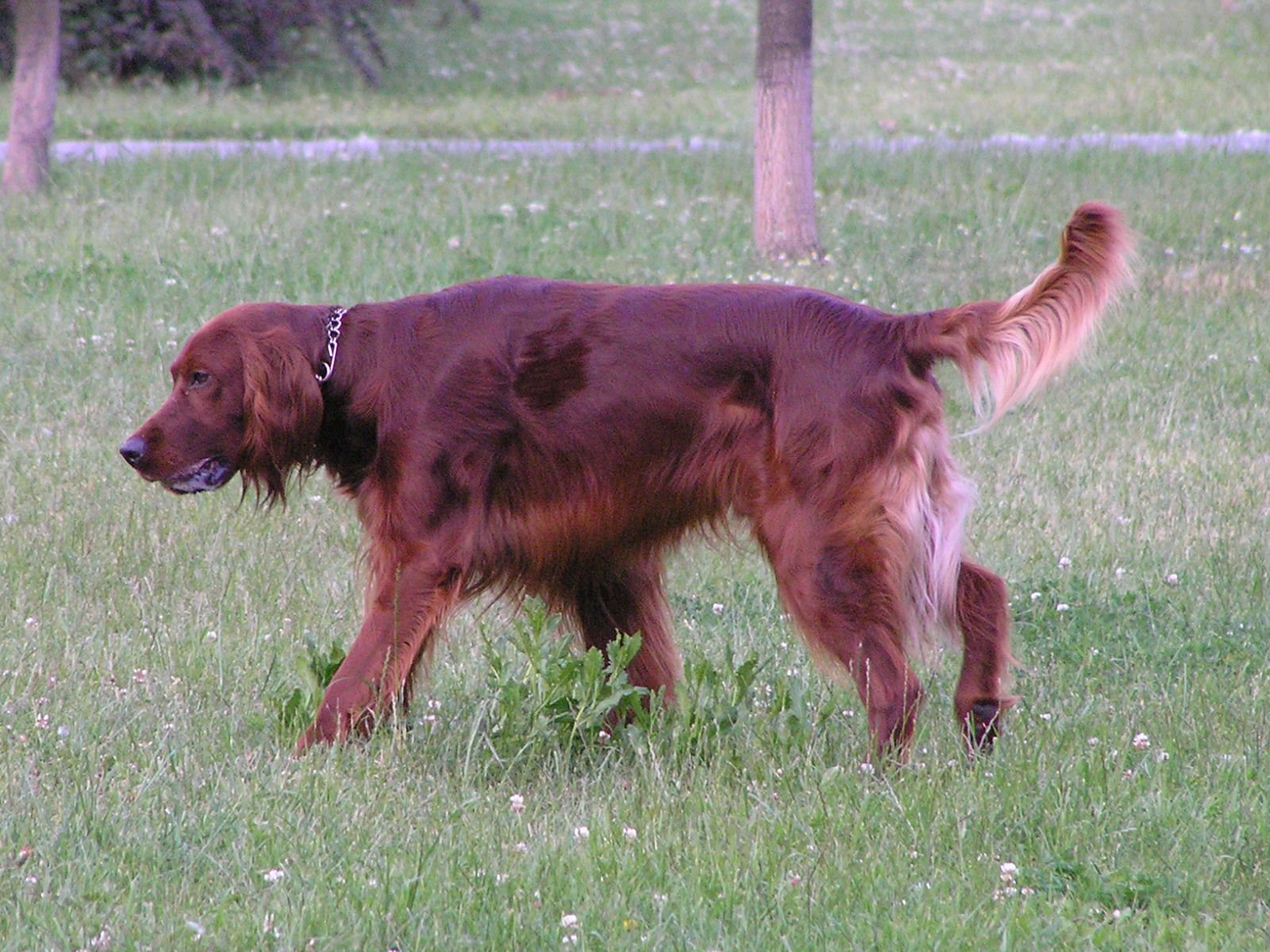
The Irish Setter is a versatile hunting dog that excels in a variety of roles, from pointing to retrieving.
They are known for their energetic and athletic nature, requiring regular exercise to stay happy and healthy. With a strong prey drive and excellent nose, Irish Setters are a joy to hunt with.
Their beautiful red coat requires regular grooming to prevent matting and tangling, and they shed heavily twice a year.
Irish Setters are generally good with children, but as with any breed, it's essential to socialize them well to ensure a harmonious household.
History of the Breed
The Irish setter has a rich history dating back to the early 1800s in Ireland, where they were bred to assist bird hunters.
Irish setters were developed from a combination of spaniels, English setters, and Gordon setters, resulting in a red-and-white setter-type dog that became known as the Irish setter.
The breed quickly gained popularity in Britain and the United States, with the first Irish setters arriving in the US in the early 19th century.
In 1878, the Irish setter was one of the first nine breeds to gain recognition from the American Kennel Club (AKC).
The breed was further divided into two sub-types: field and show, with the field-type setter retaining its working abilities and the show-type setter being bred for its appearance.
The Irish setter has excelled in various roles, including hunting, showing, and as a family pet, and has won the Westminster Kennel Club's Sporting Group competition 11 times.
Temperament
Irish Setters are a perfect match for families with kids, as they are highly affectionate and playful. They also get along great with other pets, but small animals may pose a problem due to their hunting instinct.
They are an active breed that requires long, daily walks and off-lead running in wide, open spaces. This is not a breed that can be left alone in the backyard for long periods of time.
Irish Setters are highly intelligent and respond swiftly to positive training, making them a joy to work with. They thrive on constant human companionship and enjoy having a job to do.
Characteristics and Form

Irish Setters are a medium-sized dog with a fluid, athletic frame, typically standing about 22 inches tall and weighing between 45 and 65 pounds.
Their weight is evenly distributed throughout their body, giving them a graceful appearance. A beautiful, flowing coat helps to enhance this image.
The coat of an Irish Setter can vary depending on whether they're bred for the show ring or for hunting purposes. Show dogs tend to have a thicker, longer, more mahogany-colored coat, while hunting dogs have a thinner, shorter, and more chestnut-colored coat.
Their coat helps with thermoregulation and avoiding burrs and awns. In fact, some breeders believe that an overabundance of hair is a fault in a gundog like the Irish Setter.
Irish Setters come in a range of red shades, from solid red to chestnut to mahogany. Their coat color is undoubtedly a magnificent sight.
Here are some key characteristics of Irish Setters' form:
Training
Training your Irish Setter requires a consistent and positive approach. They thrive on human companionship and can become destructive or hyperactive if left alone for long periods.
Irish Setters are intelligent and quick learners, making them a natural fit for field trials, flyball, dock diving, canine agility, and obedience. They're also well-suited as therapy or service dogs.
To train your Irish Setter, start with socialization in puppyhood, introducing them to people of all ages and animals large and small. Keep in mind their prey drive can sometimes be activated by smaller household pets.
Irish Red and White Setters are highly trainable partners thanks to their intelligence and eagerness to please. They respond well to positive reinforcement methods and plenty of patience.
A consistent bond between trainer and dog is essential for successful training. Without a strong bond, difficulties can arise. Spending time bonding with your setter will improve your relationship and enhance your dog training sessions.
Here are some key characteristics to keep in mind when training your Irish Setter:
Remember, Irish Setters are not well-suited as guard dogs, as they welcome strangers into their home. They're good with other dogs but require socialization and close supervision when interacting with prey animals.
Uses
The Irish Setter is a tireless and wide-ranging hunter, well-suited to fields and wet or dry moorland terrain. They were bred for hunting, specifically for setting or locating and pointing upland gamebirds.
The Irish Setter uses their excellent sense of smell to locate the mark, then holds a pointing position, indicating the direction in which the bird lies hidden. This natural ability makes them a valuable asset for hunters.
Prior to 1975, a relationship existed between the American Kennel Club and the Field Dog Stud Book, allowing for reciprocal registration. This relationship was severed in 1975, but working Irish Setter kennels today still field champion dogs with lines from both organizations.
Retrieving
Irish Setters make excellent retrievers on land and from water, doing it naturally and with ease. Many Irish, British, and American bird hunters expect their setters to retrieve, and it's a trait that's been observed in the breed for centuries.

In fact, Colonel Millner, a British breeder and author, noted in the early 1900s that Irish Setters make excellent retrievers, and this still rings true today. Irish Setters have an innate love for retrieving, and it's not uncommon for them to retrieve game with enthusiasm and precision.
A New Zealand-based breeder, Robyn Gaskin, has even noted that her Irish Setters are natural retrievers and make fine duck dogs. In fact, all setters in her country must retrieve in field trials run on pheasant and quail.
Headings
The Irish Setter clubs have organized themselves into various groups, each with its own name and purpose.
The International Irish Red Setter Club is a global organization that brings together Irish Setter enthusiasts from around the world.
The Irish Setter clubs in different countries have their own unique names, reflecting their local identity and culture. For example, the Irish Setter Club Deutschland e.V. is based in Germany, while the Irish Setter Club of Canada serves the Canadian community.
Curious to learn more? Check out: American Kennel Club Lancashire Heeler

The Irish Setter clubs have also established specific clubs for field trials, such as the National Red Setter Field Trial Club in the USA.
Here are some examples of Irish Setter clubs from around the world:
- Irish Red Setter Club (Ireland)
- Irish Setter Association (England)
- The Irish Setter Club of Scotland Irish Setter Club of America (USA)
- National Red Setter Field Trial Club (USA)
- Irish Setter Club of Canada
- Norskirsksetterklub (Norway)
- Svenska Irländsk Setterklubben (Sweden)
- Irish Setter Club Deutschland e.V. (Germany)
- Dansk Irsk Setter Klub (Denmark)
- lerse Setter Club (Netherlands)
- Le Red Club (France)
- Ierse Setter Club (Belgium)
- Red Setter Club d’Italia (Italy)
- Irish Setter Club (New Zealand)
- International Irish Red Setter Club
Care and Maintenance
Irish red and white setters are slow-to-mature pups who generally need more physical activity and mental enrichment than many other dog breeds.
To keep them happy and healthy, daily activity is a must - a bored IRWS can easily turn to mischief. Regular exercise and playtime will help prevent boredom and destructive behavior.
Their gorgeous red coat isn't as high-maintenance as you'd think, requiring only a couple of brushing sessions per week, as well as an occasional bath.
Exercise
Irish red and white setters are slow-to-mature pups who generally need more physical activity and mental enrichment than many other dog breeds.
To keep your IRWS happy and balanced, aim for at least an hour of vigorous activity each day. This can include a brisk walk, going for a run, or endlessly retrieving tennis balls.
A fenced yard is ideal for this breed, giving them a safe place to roam and romp. However, it won't replace the need for a daily walk or run.
Healthy adult IRWS need at least two 30-minute sessions of activity daily. This can be walking, hiking, running alongside you, swimming, or even engaging in playtime.
Because they form strong bonds with their humans, agility sports like dock diving and agility training can be a great outlet for your pup's energy.
Expand your knowledge: Pembroke Welsh Corgi Agility
Grooming
Grooming is an essential part of Irish setter care, but it's not as time-consuming as you might think.
Their coat requires a couple of brushing sessions per week, as well as an occasional bath. The undercoat sheds heavily in spring, so be prepared to ramp up your grooming during this time.
A slicker brush is perfect for removing loose hair and preventing fur balls from flying around. This will help keep your home clean and your dog comfortable.
Expand your knowledge: When Is It Best to Breed a Dog
Irish red and white setters have a bi-color coat that requires daily upkeep, especially when it comes to burrs collecting on their fine, feathery top coat.
Regular nail trimmings every three to six weeks are a must to keep your dog's nails healthy and prevent overgrowth. This will also help prevent scratching and damage to your home.
Dog-safe shampoo is a must when bathing your Irish setter, as regular shampoo can strip them of their natural oils. This can lead to dry, itchy skin and a range of other problems.
A fresh viewpoint: How Old Can Male Dogs Be to Breed
Health and Nutrition
As an Irish setter owner, you want to ensure your furry friend stays healthy and happy. This means being aware of potential health issues and taking steps to prevent them.
Irish setters can be prone to Progressive Renal Atrophy (PRA), Cancer, Epilepsy, Celiac Disease, Von Willebrand Disease, Hip Dysplasia, and Hypothyroidism.
To keep your Irish setter in tip-top shape, focus on quality dog food that's rich in protein. Work with your vet to determine the right amount of daily calories based on your dog's age, activity levels, and ideal body condition.
Irish setters can be prone to bloat, so it's essential to feed them slowly and avoid table scraps. Consider using slow-feeder dog bowls or feeding smaller, more frequent meals.
A balanced diet is crucial to maintaining your Irish setter's weight. If they become overweight, your vet may recommend a change in diet or portions.
Here are some common health problems to watch for in Irish setters:
- Progressive Renal Atrophy (PRA)
- Cancer
- Epilepsy
- Celiac Disease
- Von Willebrand Disease
- Hip Dysplasia
- Hypothyroidism
Common Health Problems
Irish setters are generally a healthy breed, but like any purebred, they can be prone to certain health issues.
One of the most common health problems in Irish setters is Progressive Renal Atrophy (PRA), a condition that affects the kidneys.
Irish red and white setters are also susceptible to hip dysplasia, a condition where the hip joint develops abnormally, causing pain and mobility issues.
Maintaining a healthy weight can help reduce strain on the hip joint and ease symptoms of hip dysplasia.
Some Irish setters may also develop Von Willebrand's Disease, a blood clotting disorder that can lead to easy bruising and excessive bleeding.
Von Willebrand's Disease can be managed with medication, but there's no cure.
Irish setters are also at risk for cancer, epilepsy, celiac disease, and hypothyroidism, among other conditions.
Here are some of the most common health problems in Irish setters:
- Progressive Renal Atrophy (PRA)
- Cancer
- Epilepsy
- Celiac Disease
- Von Willebrand Disease
- Hip Dysplasia
- Hypothyroidism
Diet and Nutrition
Irish setters need quality dog food with a protein-rich formula to stay active and healthy. This breed requires a lot of energy, so a nutrient-dense food is essential.
To determine the right amount of daily calories for your dog, work with your vet based on their activity levels and age. This will help keep your setter at a healthy weight and prevent obesity.
Irish setters can be prone to bloat, a life-threatening condition, so it's essential to feed them slowly. Using slow-feeder dog bowls or feeding smaller, more frequent meals can help prevent this issue.
Your vet can help determine the right amount of food for your individual dog based on their age, lifestyle, and ideal body condition. This will ensure your setter gets the right amount of fuel for their daily activities.
Table scraps can throw off your dog's balanced diet and contribute to weight gain, so offer them sparingly, if at all.
Curious to learn more? Check out: Why Are Labradors so Popular
Buying and Adopting
If you're looking to bring an Irish Setter into your life, finding the right one can be a challenge. This breed is highly sought after and fairly rare, making it hard to find an adoptable Irish red and white setter.
Organizations like Save Our Setters (Tennessee) specialize in rehoming setters, including Irish red and whites. They may have a setter-dedicated rescue in your area.
The Irish Red and White Setter Society of America offers a rescue program that matches dogs needing homes with suitable families. You can contact them to be notified if a dog in need of a forever home becomes available.
Adopting an Irish Setter can be a rewarding experience, but if you have your heart set on a puppy, there are reputable breeders to consider. An Irish red and white setter puppy from a responsible breeder may cost around $1,800 on average.
To ensure you're getting a healthy puppy, it's essential to meet at least one, if not both, of the puppy's parents. You should also receive health certificates from the breeder.
Additional reading: One Eyed Shih Tzu
The National Breed Club recommends the following health certifications for any litter of Irish setter puppies:
- Optigen Testing Results for Progressive Retinal Atrophy
- OFA Certification of Hips
- Eye Exam for CERF
- OFA Thyroid Panel
If you're considering buying from a breeder, be sure to check out reputable sources like the Irish Setter Club of America Breeder Listing or the American Kennel Club Breeder Listing.
Pros and Cons
If you're considering an Irish Setter or Irish Red and White Setter as your next hunting dog, you'll be delighted to know they make excellent companions. Friendly and affectionate, Irish Setters are perfect for families.
Irish Setters are highly intelligent and eager to please, making them a joy to train. They take well to commands and are quick to learn new skills. Whether you're a seasoned hunter or a beginner, an Irish Setter will be by your side in no time.
Here's a quick rundown of the pros of these breeds:
- Friendly and affectionate
- Very tolerant with children and other dogs
- Highly intelligent and eager to please
- Loyal dogs who take well to training
- Good around other dogs and children
- Doesn't tend to drool or bark a lot
Pros of the
If you're considering bringing an Irish Setter or Irish Red and White Setter into your family, you're in for a treat. These breeds are known for their friendly and affectionate nature.
They're also very tolerant with children and other dogs, making them a great choice for families with multiple pets. I've seen many families with young kids and multiple dogs, and these breeds always seem to fit right in.
One of the standout characteristics of Irish Setters is their high intelligence and eagerness to please. This makes them highly trainable, which is a huge plus for first-time dog owners.
Here are some key pros of these breeds:
- Friendly and affectionate
- Very tolerant with children and other dogs
- Highly intelligent and eager to please
- Loyal dogs who take well to training
- Good around other dogs and children
- Doesn't tend to drool or bark a lot
Cons
Irish Red and White Setters are high-energy dogs that require a significant amount of exercise and training.
They need to be taken on long walks and runs, and they also need mental stimulation through training and play. If they don't get enough physical and mental activity, they can become destructive and bored.
They also require socialization and supervision around prey animals, such as cats and pet birds, to prevent them from chasing and harming these animals. This is especially important in households with multiple pets.
Additional reading: How Much Exercise Do Labrador Retrievers Need

Some Irish Red and White Setters can easily become bored if they don't receive enough attention and stimulation, which can lead to destructive behavior.
Here are some key cons to consider:
- Needs a significant amount of exercise and training
- Requires socialization and supervision around prey animals, such as cats and pet birds
- Easily becomes bored
Frequently Asked Questions
Do Irish Setters have prey drive?
Yes, Irish Setters have a strong prey drive, which means they may chase smaller animals if not properly trained
Are Irish Setters herding dogs?
No, Irish Setters are not herding dogs, but rather hunting dogs bred for endurance and agility. They excel at running and require regular exercise and mental stimulation to prevent unwanted behaviors.
Sources
- https://en.wikipedia.org/wiki/Irish_Setter
- https://www.thesprucepets.com/irish-setter-dog-breed-profile-4775999
- https://www.thesprucepets.com/irish-red-and-white-setter-breed-characteristics-and-care-8598676
- https://projectupland.com/hunting-dogs/irish-setter-breed-profile/
- https://www.dogbreedinfo.com/irishsetter.htm
Featured Images: pexels.com


